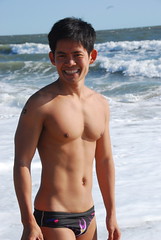Top racers are well balanced in all three sports and can make fast transitions from sport to sport. Those coming to triathlon as beginners will often have a strong sport and a weaker sport or sports. Working on the weak sports and capitalizing on the strong sport can hook athletes on triathlon for years. From the first finisher to the last comes the satisfaction of accomplishment that is based on personal measures, no matter the time on the clock. Triathlon is an attractive sport for many reasons.
Watch this video below for some quick training tips…
Though the media sweetheart of the sport is the Ironman World Championships held in Hawaii in the month of October each year, triathlon has gained worldwide popularity, in part, due to the variety of distances available. Did you want to join the elite and finish a triathlon? Learn how water can help you train.
—-
Tri training: Taking to the open water
- Open water swimming can be scary but liberating, Ironman champion says
- Make sure to do open water practice swims with other triathletes
- Wetsuits, goggles and swim caps will all help you feel comfortable in the water
My first race of 2006 was the National Sprint Championships in Redditch, England.
I borrowed a wetsuit — it didn’t fit.
I got in the water, which was 14 degrees Celsius (about 57 degrees Farenheit). The gun went off.
My wetsuit flooded.
I couldn’t get my arms out of the water, let alone swim, and had to be rescued by a kayaker. Not the most auspicious start.
Since then I have gained a little more experience in open water, and I hope the following information provides the CNN Fit Nation Team, and all of CNN’s readers, with some useful tips for swimming in open water. Swimming in open water can be scary, but it can also be liberating, fulfilling and enjoyable.
It’s important to feel comfortable in open water before you can really enjoy it. And to feel comfortable, you have to understand what the water can do, what you can do, and be confident that you can handle both the expected and the unexpected.
If you’ve never raced in open water, you should try to do some practice open water swims — in the ocean and with others around — to build experience and confidence. So, first things first: What equipment do you need for your open water swimming experience?
Wetsuit
Wetsuits (or wetties) are made of neoprene, which allows a very thin layer of water between skin and suit. This water warms and the insulation keeps you warm.
Of course, it is important that as little water as possible enters the suit and is not being constantly replaced by cold water flushing through. This is why wetsuits should fit snugly.
In addition to warmth, wetsuits provide buoyancy, assist in better form and technique, reduce drag and help protect against sharp objects, including flailing limbs.
As the water temperature will be 62 to 66 degrees in California, wetsuits are not compulsory at the Nautica Malibu Triathlon, but are allowed. I suggest those on the CNN Team wear wetsuits, especially the beginners.
Goggles
Find a pair that you are comfortable with and that allow you to see very well.
Make sure they are tight, but not so tight that they cause pain around your eyes. Spit is the best anti-fogging agent around, and it’s free!
Always make sure to inspect your goggles for wear and tear the day before your race. I always go to a race with two pairs of goggles: a tinted pair for sunny days and a clear pair for dark days.
If you have a ponytail, tie it at the nape of your neck, so the goggle-strap is above the ponytail bulge.
Swim cap
You will be given a specific, color-coded cap to wear in your triathlon. If possible, try on the race cap the day before. Carefully stretch it a little if it feels too tight.
You might consider having your goggles strap under your cap, which can help prevent your goggles from getting removed or dislodged in the swim.
Silicon ear plugs
Ear plugs are also very useful if you suffer from ear infections and/or if the water is cold.
Vaseline
Chafing is a triathlete’s worst enemy. It is often worse in the sea, where salt creates extra friction. Vaseline is an easy solution to chafing, though petroleum jelly can cause wetsuit neoprene to deteriorate over time.
If you do use Vaseline, apply it with a rubber glove or bag over your hand (oily hands affect the catch in the swim).
Many athletes use cooking spray (such as Pam) for lubrication. There are also some great wetsuit-friendly lubricants on the market, many of which come in a convenient roll-on stick.
Throwaway shoes
Buy some cheap, throwaway slippers and/or flip flops to wear down to the swim start. This helps avoid cold feet (literally) and prevents any cuts on sharp objects.
Preparing to start
Look at the swimming maps and FAQs for the race, and even seek advice from athletes who have done the course before.
It is important to know the swim cut-off time, and be confident you can complete the course within this time. Do at least one practice swim, to familiarize yourself with currents, rocks and possible hazards.
Many triathlons start in groups, divided by age. If possible, watch the first swimmers to get an indication of the best line to the first buoy.
Position yourselves at the back or the side of the start group, to avoid the main melee. Yes, you may swim slightly farther than those who start at the front or middle of the pack, but you will also reduce the risk of panic or disruption.
During the race, avoid panting or holding your breath which can exacerbate problems if you begin to panic in the water. If you feel yourself becoming anxious, focus on intrinsic factors that you can control, such as calm and controlled breathing.
If you do want to take some time out, slowly twist your head to the side, breathe and slowly lift your head out. Do a few strokes of breaststroke or tread water, take long slow breaths, look around, find your bearings and slowly start swimming when you feel ready.
Open water swim strokes
It is important to remember that pool swimming can be very different from open water swimming in terms of strategy, pacing and technique.
Many of you know how difficult it is to maintain a uniform stroke due to the varying conditions, the buoys and the proximity of other swimmers and the need to conserve energy for the bike and run. One way to help ensure this is to take relaxed, deep inhales and long, full exhales, keeping faces and necks as relaxed as possible.
The question of bilateral (breathing to both sides) versus one-sided breathing is the subject of controversy. Bilateral breathing does help to balance out your stroke, as well as create symmetry in your back and shoulder muscles.
I breathe on one side — every second stroke to the right.
Unnatural technique could result in less breaths which could lead to oxygen debt, a definite drag on performance.
For this reason, during the race, follow a pattern that feels natural to you.
Even if you do favor one side, you should still practice bilateral breathing in training, as you may need to breathe to your less dominant side during the open water swim to help with navigation, avoid chop, waves or glaring sun, or to prevent another swimmer punching you in the nose. In open water, the stroke needs to be faster, shorter and continuous to minimize the disruption of our forward progress. An overly-long stroke or glide can be less efficient because of the introduction of dead spots and pauses.
You should have a flattish and wide-hand entry, a high elbow to provide a strong anchor for the catch phase, a backwards pull that comes straight to the side (rather than an “s” shape under the body), and a quick recovery.
Unless you are turning your head to breathe, your eyes should be focused towards the bottom, rather than looking forward, which lifts your neck and can cause your legs to sink. Swimming in choppy conditions may mean that you need to use a higher arm recovery. If it’s too low, your hand could enter the water too early or be hit by a wave unexpectedly, causing you to unbalance.
You can also use your arm recovery to wriggle your fingers to relax your arms and increase blood flow, especially if the water is cold.
Sighting and navigation
It’s easy to sight in a pool — you simply follow the black line. Unfortunately there are no such lines in the open water.
In open water, you could simply follow the bubbles of the feet in front of you, but you are placing your trust in that swimmer to go the right way.
You should be able to periodically “sight” or “spot” to make sure you are heading in the right direction. To sight, you need a marker. This can be one of the race buoys, or a landmark you identify prior to the race.
The best way to sight during a race is to press down lightly on the water with your lead arm, lift the head slightly above the goggle line just before you want to take a breath, look forward, and as you lower it, then turn your head to the side to breathe.
Don’t try to breathe and sight at the same time, otherwise you will lift your head too high and your hips and legs will drop.
A common question is “How often should I sight?” If you naturally swim straight, you can sight every 12 to 15 strokes. If you have a little more trouble swimming straight, you should sight more frequently, say every seven to nine strokes.
Final words
Open water swimming presents the a great endurance adventure. It is you against the elements — and a few hundred other people.
Prepare for the expected, as well as the unexpected.
As with the whole race, the swim offers an opportunity to test your limits, tackle fears and have some fun.
Triathlon is contested as a single sport, but is actually comprised of three sports: swimming, cycling and running. Today, most races are staged in that order—swim, bike and then run—but there remain a few exceptions. In the early triathlons, it was common to have swimming as the last event. Race organizers thought it was logical to swim at the end of the race in order to cool off. As more and more competitors began to enjoy triathlon, it became obvious that it is unsafe to swim at the end of the event when people have the most fatigue. Your total event time begins  when the gun goes off to start the swim, and ends when you cross the finish line after the run. That means your event time includes the total of your swim, the time it takes you to transition from swimming to cycling (commonly called transition 1, or T1), the time it takes you to complete the bike ride, the time it takes you to transition from cycling to running (commonly called T2) and your run time.
when the gun goes off to start the swim, and ends when you cross the finish line after the run. That means your event time includes the total of your swim, the time it takes you to transition from swimming to cycling (commonly called transition 1, or T1), the time it takes you to complete the bike ride, the time it takes you to transition from cycling to running (commonly called T2) and your run time.
Are you ready to start training?
|
Gain 10lbs of Muscle in 30 Days?
Grab this free Muscle Gaining Plan that includes the workout and diet plan. Just Enter Your Email Below.
|

|

|
We hate spam just as much as you
|


{ 0 comments… add one }